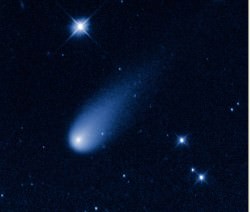This question comes from Andrew Bumford and Steven Stormont.
In a previous episode I’ve talked about how the entire Solar System collapsed down from a cloud of hydrogen and helium left over from the Big Bang. And yet, we stand here on planet Earth, with all its water. So, how did that H20 get to our planet? The hydrogen came from the solar nebula, but where did the oxygen come from?
Here’s the amazing part.
The oxygen came from stars that lived and died before our Sun was even born. When those stars puffed out their final breaths of oxygen, carbon and other “metals”, they seeded new nebulae with the raw material for new worlds. We owe our very existence to the dead stars that came before.
When our Sun dies, it’ll give up some of its heavier elements to the next generation of stars. So, mix hydrogen together with this donated oxygen, and you’ll get H20. It doesn’t take any special process or encouragement, when those two elements come together, water is the result.
But how did it get from being spread across the early Solar System to concentrating here on Earth, and filling up our oceans, lakes and rivers? The exact mechanism is a mystery. Astronomers don’t know for sure, but there are a few theories:
Idea #1: impacts. Take a look at the craters on the Moon and you’ll see that the Solar System was a busy place, long ago. Approximately 3.8 to 4.1 billion years ago was the Late Heavy Bombardment period, when the entire inner Solar System was pummeled by asteroids. The surfaces of the planets and their moons were heated to molten slag because of the non-stop impacts. These impactors could have been comets or asteroids.
Comets are 80% water, and would deliver vast amounts of water to Earth, but they’re also volatile, and would have a difficult time surviving the harsh radiation of the young Sun. Asteroids have a lower ratio of water, but they could protect that water a little better, delivering less with each catastrophic impact.

Astronomers have also found many hybrid objects which contain large amounts of both rock and water. It’s hard to classify them either way.
Idea #2 is that large amounts of water just came directly from the solar nebula. As we orbited around the young Sun, it passed through the water-rich material in the nebula and scooped it up. Gravitational interactions between the planets would have transferred material around the Solar System, and it would have added to the Earth’s volume of water over hundreds of millions of years.
Of course, it’s entirely possible that the answer is “all of the above”. Asteroids and comets and the early solar nebula all delivered water to the Earth. Where did the Earth’s water come from? Astronomers don’t know for sure. But I’m sure glad the water is here; life here wouldn’t exist without it.

